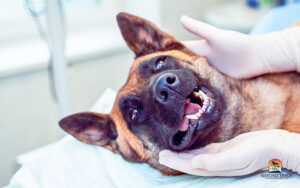Pet seizures can be one of the most alarming experiences for any pet owner. Picture this: you arrive home to find your usually playful dog, Max, trembling uncontrollably on the floor, his legs thrashing and his eyes unfocused.
In that moment of sheer panic, it’s hard to know what to do or how to help. This unsettling scenario is all too familiar to those who have pets suffering from seizures.
Whether it’s a dog or a cat, these sudden episodes can leave you feeling helpless and anxious.
Watch this video of Dr. Smith explaining what pet seizures are and what you can do once it happens:
Understanding pet seizures—what causes them, how to recognize them, and what steps to take—can transform a frightening situation into a manageable one.
This guide will provide the essential knowledge and practical tips you need to care for your pet during and after a seizure, offering reassurance and actionable advice for those tough moments.
What Causes Seizures in Pets?
Seizures in pets can have various causes. While epilepsy is the most common reason, other factors can also trigger these episodes.
Epilepsy
 Epilepsy is a neurological disorder causing abnormal electrical activity in the brain, leading to seizures. It’s the leading cause in dogs, ranging from mild to severe episodes. Long-term medication and regular vet care are often needed to manage it.
Epilepsy is a neurological disorder causing abnormal electrical activity in the brain, leading to seizures. It’s the leading cause in dogs, ranging from mild to severe episodes. Long-term medication and regular vet care are often needed to manage it.
Genetic Predispositions
Certain breeds, like Beagles, German Shepherds, and Border Collies, are more prone to seizures due to genetic factors. Knowing your pet’s breed-specific risks can help you stay vigilant and seek timely veterinary advice.
 Injuries or Trauma
Injuries or Trauma
Head injuries from falls, accidents, or rough handling can damage the brain and trigger seizures. Even if a pet appears to recover without symptoms, seizures can develop later due to delayed effects of brain injuries.
Health Conditions
Various health issues can lead to seizures:
- Illness or Infection: Underlying health issues such as brain tumors, liver disease, kidney disease, or infections (e.g., distemper, encephalitis) can cause seizures.
- Tumors: Brain tumors disrupt regular brain activity, often leading to seizures, especially in older pets.
- Metabolic Disorders: Hypoglycemia (low blood sugar), electrolyte imbalances, or other metabolic conditions can lead to seizures.
- Poisoning: Ingesting toxic substances like chocolate, certain chemicals, or medications can provoke seizures and require immediate vet attention.
- Hormonal Imbalances: Conditions like hypothyroidism or other hormonal imbalances can contribute to seizure activity.
- Age-Related Factors: Older dogs may develop conditions such as brain tumors or cognitive dysfunction that can increase the likelihood of seizures.
Environmental Factors
 Stressors such as loud noises, routine changes, or new household additions can trigger seizures in some pets.
Stressors such as loud noises, routine changes, or new household additions can trigger seizures in some pets.
Identifying and managing environmental triggers can help reduce the frequency of seizures.
Common environmental triggers are:
- Food Ingredients: Certain foods, especially those containing artificial additives, preservatives, or certain chemicals, can trigger seizures. Chocolate, caffeine, and foods high in sodium are also known to be problematic.
- Environmental Factors: Sudden environmental changes, such as loud noises (fireworks, thunderstorms), bright or flashing lights, and stressful situations, can trigger seizures in some pets.
- Medications: Some medications, including flea and tick preventatives, vaccines, or other drugs, can potentially trigger seizures in sensitive pets.
- Toxins: Exposure to toxins, including household chemicals, pesticides, certain plants, and poisonous substances like antifreeze or rat poison, can trigger seizures.
- Lack of Sleep or Overexertion: Extreme fatigue, lack of sleep, or overexertion can sometimes trigger pet seizures.
- Heat Stroke: Overheating or heat stroke can cause seizures, particularly in dogs during hot weather or strenuous exercise.
While some triggers can be easily identified, others may be more elusive or variable. But it’s best to try and discover what the triggers are. Understanding the causes of seizures in pets—from epilepsy and genetic predispositions to injuries and environmental factors—helps manage and provide timely care for your furry friends.
Understanding the Your Pet’s Seizure Triggers
Understanding what triggers your pet’s seizures can be crucial in managing and preventing them.
Here are several ways this knowledge can help:
- Avoiding Triggers: Identifying specific triggers allows you to minimize or eliminate exposure to them. Common triggers include certain foods, environmental stressors, flashing lights, loud noises, or certain medications.
- Monitoring and Record Keeping: Recording your pet’s seizures in detail, including potential triggers, frequency, duration, and severity, can help your veterinarian make more informed decisions about treatment and management.
- Adjusting Environment: Changing your pet’s environment to reduce stress and anxiety can significantly lower the risk of seizures. This could include creating a calm space, reducing exposure to loud noises, and maintaining a consistent routine.
- Diet and Nutrition: Some seizures can be triggered by specific foods or nutritional deficiencies. Working with your vet to identify any dietary triggers and adjusting your pet’s diet can help prevent seizures.
- Medication Management: If your pet is on medication, understanding potential side effects and interactions can help you manage and adjust their treatment plan to reduce seizure risk.
- Health Monitoring: Recognizing the signs that precede a seizure can allow you to take preventive actions, such as administering prescribed medication early or moving your pet to a safe area.
- Guidance: By clearly understanding the triggers, your veterinarian can tailor a more effective treatment plan, including medication, lifestyle changes, or alternative therapies such as acupuncture or herbal medicine.
By proactively identifying and managing these triggers, you can significantly improve your pet’s quality of life and reduce the frequency and severity of seizures. Always consult with your veterinarian for a tailored care plan.
Recognizing Seizures: Key Signs
During a seizure, pets may exhibit several behaviors:
- Shaking or convulsing: Involuntary muscle movements.
- Falling: Pets often collapse or fall on their side.
- Paddling: Repetitive, swimming-like movements with their legs.
- Unconsciousness: A significant indicator is a change in their mental state; they may be unaware of their surroundings.
What to Do During a Seizure
 When your pet is having a seizure:
When your pet is having a seizure:
- Stay calm: Panicking can add stress to your pet.
- Leave them alone: Do not try to hold or restrain them. Contrary to myth, pulling their tongue out does not help.
- Protect them: Move objects away that could cause injury.
Remember the first rule of medicine: “First, do no harm.”
When to Seek Veterinary Help
After a seizure, observe your pet closely. Typically, it’s not an emergency if they recover quickly. However, seek immediate vet assistance if:
- A seizure lasts more than 5-10 minutes: Prolonged seizures can cause additional health issues.
- Multiple seizures occur in a day: Frequent seizures require urgent medical attention.
Natural Remedies for Pet Seizures
 Managing pet seizures naturally can complement traditional treatments. For some pets, natural treatments eliminate seizures, and no medication is needed. Often, Dr. Smith will try a TCVM herbal formula before putting a pet on seizure medication.
Managing pet seizures naturally can complement traditional treatments. For some pets, natural treatments eliminate seizures, and no medication is needed. Often, Dr. Smith will try a TCVM herbal formula before putting a pet on seizure medication.
For example, Herbsmith Rx Gastrodia Settle Seizures contains powerful herbs that reduce episodes of pet seizures.
Di Tan Tang and Bu Xue Xi Feng are other TCVM herbal formulas that may help reduce the frequency and severity of pet seizures.
Some other TCVM herbal formulas can also help, depending on your pet’s TCVM exam results.
Diet Adjustments
Switching your pet’s diet from dry kibble to wet or canned food can be beneficial. Dry kibble sometimes lacks the moisture and nutrients necessary for optimal brain health. Wet or canned foods often provide better hydration and higher-quality nutrients, supporting overall well-being and potentially reducing seizure frequency.
- Why it helps: Better hydration and nutrient absorption can stabilize blood sugar and support brain health, which is crucial in managing seizure-prone pets.
MCT Oil
 Medium-chain triglyceride (MCT) oil is a fat quickly digested and absorbed by the body. It provides a quick energy source for the brain. MCT oil is often included in specialized seizure diets and can be added to your pet’s food.
Medium-chain triglyceride (MCT) oil is a fat quickly digested and absorbed by the body. It provides a quick energy source for the brain. MCT oil is often included in specialized seizure diets and can be added to your pet’s food.
- Why it helps: MCT oil has been shown to have neuroprotective properties and can help stabilize brain function, which is beneficial in managing epilepsy. It supports brain metabolism and may reduce seizure frequency and intensity.
We recommend Ayush Pet CoCurcumin MCT Coconut Milk Powder. This Powder contains MCT, plus other ingredients that help prevent seizures.
Incorporating natural remedies like dietary changes and MCT oil into your pet’s care routine can offer additional support in managing seizures.
Always consult your veterinarian before making any changes to ensure these approaches are safe and appropriate for your pet’s needs.
Conclusion
 Caring for a pet experiencing seizures can be daunting, but understanding the causes, recognizing the signs, and knowing how to manage these episodes can make a significant difference. Seizures in pets, whether due to epilepsy, injury, or other health issues, require careful attention and, often, ongoing treatment.
Caring for a pet experiencing seizures can be daunting, but understanding the causes, recognizing the signs, and knowing how to manage these episodes can make a significant difference. Seizures in pets, whether due to epilepsy, injury, or other health issues, require careful attention and, often, ongoing treatment.
From making diet adjustments and considering natural remedies like MCT oil to knowing when to seek immediate veterinary help, these strategies can help you support your pet during and after seizures. Remember, while some seizures are manageable at home, persistent or severe episodes necessitate professional veterinary care.
By staying informed and proactive, you can provide the best possible care for your furry friend, ensuring they continue to lead a happy and fulfilling life despite the challenges of seizures. Always consult your veterinarian for personalized advice and treatment options tailored to your pet’s needs. With the right approach and support, many pets with seizures can thrive and enjoy a high quality of life.
Does your pet struggle with seizures? We can help!







